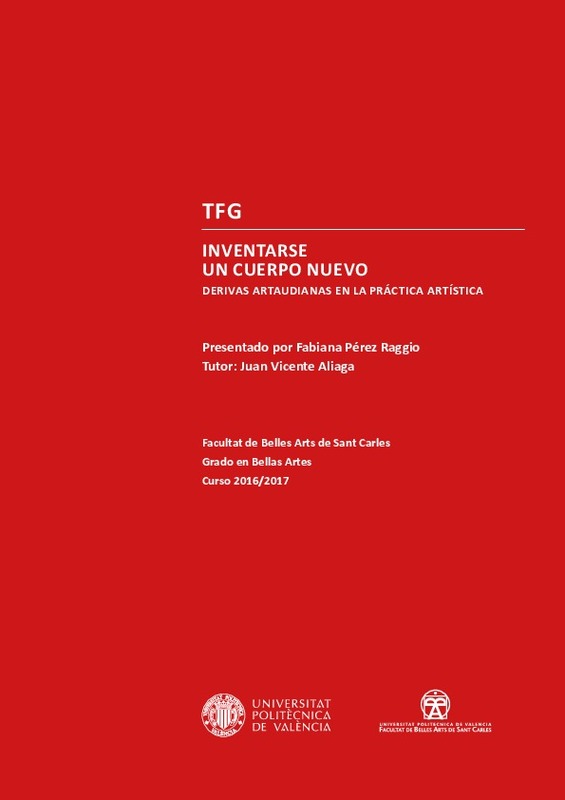JavaScript is disabled for your browser. Some features of this site may not work without it.
Buscar en RiuNet
Listar
Mi cuenta
Estadísticas
Ayuda RiuNet
Admin. UPV
Inventarse un cuerpo nuevo. Derivas artaudianas en la práctica artística
Mostrar el registro sencillo del ítem
Ficheros en el ítem
| dc.contributor.advisor | Aliaga Espert, Juan Vicente
|
es_ES |
| dc.contributor.author | PÉREZ RAGGIO, FABIANA ADRIANA
|
es_ES |
| dc.date.accessioned | 2018-02-09T12:54:33Z | |
| dc.date.available | 2018-02-09T12:54:33Z | |
| dc.date.created | 2017-09-27 | es_ES |
| dc.date.issued | 2018-02-09 | es_ES |
| dc.identifier.uri | http://hdl.handle.net/10251/97597 | |
| dc.description.abstract | El trabajo presente responde a las inquietudes literarias y artísticas despertadas por la obra ensayística de Antonin Artaud. Se pondrá el foco de atención en los escritos "El Teatro y su doble" (1938) y "Para terminar con el juicio de dios" (1947). A partir de su análisis se extraerán las características que conforman el pensamiento artaudiano. Por otro lado, el resultado de ese análisis compondrá una herramienta fundamental para la creación artística. Se trata de una propuesta teórico-práctica, donde la obra de Artaud supone un punto de inflexión que permite llevar el arte a la vida y viceversa. La producción artística que se planteará estará vinculada no sólo a los escritos que dejó el autor, sino al resto de pensadores y artistas que se vieron directamente influenciados por el pensamiento artaudiano. | es_ES |
| dc.description.abstract | This final degree project it¿s an answer to literary and artistic concerns awaked by Antonin Artaud¿s essays. Two main essays will be the focus of attention: "The Theatre and its Double" (1938) and "To Done with the Jugdment of God" (1947). As of the analysis it will consist of extracting features that shape Artaud¿s way of thinking. The result of this analysis will compose a fundamental tool for the artistic production. It is a theorical-practical proposal, in which Artaud¿s work involves a turning point that allows to bring art to life, and vice versa. Therefore, artistic production will be linked, not only with essays that the author produced, but with the rest of artists and great thinkers that were directly influenced by Artaud¿s thoughts. | en_EN |
| dc.language | Español | |
| dc.publisher | Universitat Politècnica de València | es_ES |
| dc.rights | Reconocimiento - No comercial - Compartir igual (by-nc-sa) | es_ES |
| dc.subject | theatre | en_EN |
| dc.subject | body without organs | en_EN |
| dc.subject | language | en_EN |
| dc.subject | becoming | en_EN |
| dc.subject | Deleuze | en_EN |
| dc.subject | Artaud | es_ES |
| dc.subject | teatro | es_ES |
| dc.subject | cuerpo sin órganos | es_ES |
| dc.subject | performance | es_ES |
| dc.subject | lenguaje | es_ES |
| dc.subject | devenir | es_ES |
| dc.subject.classification | ESCULTURA | es_ES |
| dc.subject.other | Grado en Bellas Artes-Grau en Belles Arts | es_ES |
| dc.title | Inventarse un cuerpo nuevo. Derivas artaudianas en la práctica artística | es_ES |
| dc.type | Proyecto/Trabajo fin de carrera/grado | es_ES |
| dc.rights.accessRights | Abierto | es_ES |
| dc.contributor.affiliation | Universitat Politècnica de València. Departamento de Escultura - Departament d'Escultura | es_ES |
| dc.contributor.affiliation | Universitat Politècnica de València. Facultad de Bellas Artes - Facultat de Belles Arts | es_ES |
| dc.description.bibliographicCitation | Pérez Raggio, FA. (2017). Inventarse un cuerpo nuevo. Derivas artaudianas en la práctica artística. http://hdl.handle.net/10251/97597 | es_ES |
| dc.description.accrualMethod | TFGM | es_ES |
| dc.relation.pasarela | TFGM\58053 | es_ES |
Este ítem aparece en la(s) siguiente(s) colección(ones)
-
BBAA - Trabajos académicos [5086]
Facultad de Bellas Artes






